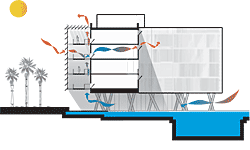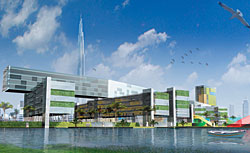Getting Aggressive About Passive Design
|
|
Although software tools have helped justify designs to risk-averse clients, some architects have returned to the pre-air-conditioning era for inspiration. Architects and engineers must discard a lot of cultural baggage to implement natural ventilation schemes. Modern air-conditioning, arguably first installed in Brooklyn in 1902 by Carrier, took decades to become what Philip Johnson would call a crutch-an easy solution allowing architects to block out the real world, hermetically sealing our daily lives in a cocoon of ignorant bliss. Not until movie theaters widely adopted the technology in the 1920s did the public begin to demand it. ASHRAE first institutionalized occupant comfort levels with a chart for engineers in 1924. That became Standard 55 in 1974, which for years has supported the case for air-conditioning for nearly every building in America.
|
||||
Grimshaw Architects looked at 19th-century European rail stations to find design tactics for the Southern Cross Station, completed in Melbourne, Australia, in 2006. Victorian stations typically had high barrel vaults that would help force a plume of smoke up away from travelers, with linear clerestory vents along the top of the arch for exhaust. Grimshaw implemented a more high-tech version of this with a domed, double-skinned roof that would absorb heat and contaminants into an open, gridlike inner layer, which would then exhaust through a 16-inch cavity out of "moguls" at each peak. CFD modeling showed that wind sweeping across the top of the roof would engender a pressure differential, or stack effect, at the mogul openings, naturally pulling the heat out of the cavity. Engineers considered a variety of airborne contaminants-sulfur dioxide, nitrous dioxide, and carbon monoxide-to ensure the system would work under every condition. Keith Brewis, a director in Grimshaw's Melbourne office, says a 1-foot opening along the ground plane of each wall's facade supplies the station's air for the system to work. "During the competition phase, we hadn't done the CFD analysis, so we made a provision in the plan and cost to put a fan in the apex of the domes," Brewis says. "But we've been open and there hasn't been a concern."
Although Brewis says Grimshaw seeks to implement natural ventilation schemes on every project, he feels governments should lead the call to action since leasing agents can thwart a developer from even considering unconventional design approaches. While enlightened clients help, in nearly every case discussed in this article designers stressed the need to educate clients. SCB's Patterson says Loyola approached the topic unenthusiastically until the architects took the university's key players to visit similarly ventilated buildings Schuler had designed in Germany. Scott Frank, a mechanical engineer with Jaros Baum & Bolles in New York, says it can be a tough sell since owners view the components that make mixed-mode systems function as adding directly to cost and maintenance. "In the end, facades of buildings are going to have to be a more active component of design," Frank says, suggesting perhaps the integration of radiant systems into facade components as one potential solution. Although eliminating air-conditioning sounds radical in 2007, the possibilities for an architecture unburdened by its demands clearly remain open to discussion.











